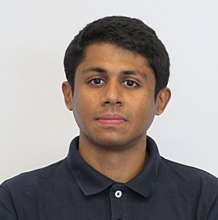 Long title
Long title
Contrast-agnostic Segmentation of the Spinal Cord from Magnetic Resonance Images
Short title
Contrast-agnostic Spinal Cord Segmentation
1) Short presentation: First name, last name, program of study, supervisor, what is your research about
My name is Naga Karthik Enamundram. I am third year PhD student in the Biomedical Engineering Department supervised by Profs. Julien Cohen-Adad and Sarath Chandar. My research focuses on the application of deep learning methods for the automatic analysis of the brain and spinal cord magnetic resonance (MR) images using real-world clinical data.
2) What was your method of explaining your thesis in 3 minutes?
I first familiarized myself with the format of the competition by looking at several presentations from the past and understanding how the students have tried to condense their research within 3 minutes. Then, I discussed a few drafts of my presentation with my colleagues and supervisors to get their feedback about the clarity and the content of my presentation. Then, I practiced my talk several times to ensure that it fits within 3 mintues.
3) What inspires you to do research?
Bridging the gap between the rapid advancements in machine learning and their successful translation to clinical workflows is one of my primary motivations. Developing open-source methods that are easily accessible to clinicians/researchers and more importantly, reproducible, are the two main factors that inspire me to do research.
4) If you have to dedicate your research to anyone in the past, present, or future, who would it be and why?
I would dedicate my research to my parents who have supported me at every step of my research journey. Pursuing a PhD in a different country, far away from home, is not easy and I am always grateful for their support. I am also thankful to my supervisors who have invested their time and resources in guiding me at various stages of my PhD.
5) 3 key words to define your research
Medical imaging, deep learning, spinal cord


